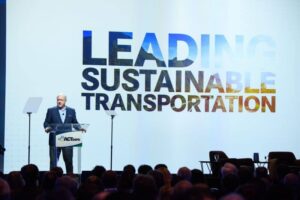
 Posted by Pam Hoddinott
Posted by Pam Hoddinott The Act Expo – Advanced Clean Transportation Expo – is a 4-day fleet conference focused on advanced fleet vehicles, fuels, and technologies. It is touted as the nation’s largest sustainable transportation networking event.

Photo credit: ACT Expo / ACT News, LinkedIn
The conference spotlights the latest fleet trends, solutions, and policies that are changing commercial transportation. The Expo is where the world’s top organizations showcase their products and solutions designed to decarbonize transportation.
ACT Expo 2023 did not disappoint. It was a highly attended show – 12,000+ attendees compared to 8,500 the previous year – where many interesting topics emerged. Chateau Energy attended and participated in ACT Expo. Here are four noteworthy takeaways from our team.
ACT Expo 2023 was the “who’s who” of the zero-emission transportation community across the country and the globe. The show floor space was incredible, comprised of hundreds of large and small vendors passionate about driving the decarbonization of the transportation industry. It included vehicle OEMs such as Daimler, Navistar, Volvo, Paccar, and Nikola in the commercial vehicle market. The charging community was also well represented this year by the likes of ChargePoint, Blink, BorgWarner, Heliox, and many more.
This year’s ACT Expo primarily focused on battery-electric vehicles (BEV), with a big showing by many OEMs with new vehicles that have been brought to market during the last few years. Hydrogen fuel-cell trucks and fueling stations for Class 3 through 8 vehicles were also highlighted this year.

Photo credit: ACT Expo / ACT News, LinkedIn
I have attended ACT Expo over the past decade. Historically, the event was predominantly about natural gas conversion vehicles and new natural gas commercial vehicles. There were a few startup battery-electric chassis companies that simply “Frankensteined” internal-combustion chassis to fashion electric models.
I remember those early years working with several of our clients who were early adopters of electric and natural gas vehicles. These clients wanted to decarbonize their fleets, and their ambitions have only grown stronger.
Being part of this EV revolution during the past decade has been a real pleasure. We’ve been involved in the electric vehicle infrastructure business since 2009 and have enjoyed watching the industry grow. Most interestingly and more importantly, it is helping fleets change convert their fleet makeup from Internal Combustion Engine (ICE) vehicles to alternative fuels like battery-electric, natural gas, or hydrogen fuel cell.
To sum up ACT 2023, there was no way to miss the buzz happening at the Anaheim Convention Center. More than 12,000 enthusiastic professionals were working together to solve various interesting and challenging problems, from infrastructure issues to utility power problems. The market is facing the ‘chicken or egg’ paradox – should the EV trucks be built first, or should the EV charging infrastructure come first?
However this plays out, there is no doubt that battery-electric vehicles and all other alternative transportation options for commercial use are here to stay. The ecosystem is growing at hyper-speed, backed by new funding. There is nearly $30+ billion a year that will be pumped into this industry, and it can’t go anywhere but forward. I am excited that Chateau Energy will continue to be a part of that growth.
Written by Jim Dore, VP of Service Solutions, Chateau Energy. Connect with Jim on LinkedIn.
ACT Expo 2023 brought together fleets, vehicle OEMs, fuel providers, and policymakers in Anaheim, CA. This year’s record attendance offered a glimpse into the dynamics at play in the commercial transportation and logistics industries. Most of the week’s discussion topics were familiar, highlighting the challenges of scaling electric fleets, securing grant funding for infrastructure projects, and successful public-private partnerships.
However, unlike years past, an air of certainty occupied the Anaheim Convention Center. Where discussions used, to begin with ‘if,’ speakers now began presentations with ‘when.’ This past weekend, I spent time thinking about why vehicle electrification is now a matter of when not if.
Downward Price Pressure on Electric Vehicles. Electric vehicles are quickly becoming less expensive. The trend is clear in the passenger EV market, where Tesla is leveraging its scale to drive a price war among its competitors. In the commercial EV market, vehicle OEMs like Daimler, Volvo, and Paccar have announced serial production beginning as soon as the fall of 2023.

In addition to the economies of scale that will soon be enjoyed by electric truck buyers, the cost and capability of battery technology are falling rapidly. At the Shanghai auto expo, the world’s largest battery maker, CATL, unveiled a battery with twice the energy density as Tesla’s market-leading battery technology. While details about the new battery remain unknown, CATL will begin mass production later this year.
Finally, electric motors are drastically more efficient than their internal-combustion counterparts. According to the U.S. Department of Energy, electric motors convert over 77 percent of electrical energy into mechanical energy, or motion, compared to less than 40 percent for a gas combustion engine. This reality is disrupting other areas of our economy as well, most ironically in upstream oil and gas operations.
Upward Price Pressure on ICE Vehicles. Internal-combustion vehicles are quickly becoming more expensive. In January of this year, the Environmental Protection Agency issued its most stringent NOx emissions regulations, which will take effect beginning with model year 2027. At ACT Expo 2023, I had several conversations centered on these regulations and their expected impact on the transportation industry. The consensus appears to be that an EPA-compliant diesel engine will require a monumental development effort from manufacturers, likely making the engine cost prohibitive. While not on its face, the EPA rule will functionally eliminate diesel technology from the country’s operating stock beginning in the model year 2027.
Finally, as manufacturers gradually transition their product lineups away from ICE technology, the aftermarket support on these vehicles will become more expensive than today. Spare parts will be harder to source, manufacturers’ warranties will be reduced, and insurance providers will hike premiums as electric trucks capture a larger share of OEM sales.
Written by Michael Bresnahan, Infrastructure Development at Chateau Energy. Connect with Michael on LinkedIn.

Photo credit: ACT Expo / ACT News, LinkedIn
From the beginning ACT keynote speaker on Monday, it was apparent that the missing piece in the transition from ICE to EV is now the electrical infrastructure. Throughout the sessions and even on the Expo floor, the conversation about the needed infrastructure was the central focus. There are three key points to this infrastructure piece that make it so difficult. The first is the strained electric utility grid. Electric companies are being inundated by interconnection study requests from many booming industries, and EVs facilities are in line with the rest. The second hurdle is getting the required infrastructure equipment, some of which is in critically low supply. Finally, the last topic of conversation was the lack of trained electricians to do the actual installation work.
All three issues of these key points boil down to the lack of qualified labor. Most of the education during the past few decades has been steered away from trade labor and into the STEM (science, technology, engineering, and mathematics) disciplines. This has led to the lack of trained and qualified personnel in the craft and trade disciplines.
An example is the small labor pool for the mining of raw materials or manufacturing quality products like transformers, switches, and breakers. Many of these materials, products, or subcomponents are now sourced from overseas or are in short domestic supply, all because we cannot produce more without the people to make them.
This lack of labor is also prevalent in the electrical construction industry. Apprenticeships to become a master electrician can take years but will ultimately provide a high living wage. However, most new high school graduates are not exposed to this trade as a viable career. Even if a high school graduate is steered toward engineering, most electrical engineering students don’t even see the electrical utility industry due to the luster of robotics or other “high-tech” areas in the academic world.
The brain drain that has occurred across these markets will be detrimental to our growing society, and unfortunately, it may take some time for that craft knowledge to resurface. The promising thing is that the collective EV industry, as well as several other industries, has seen this and is now talking about how to adapt or rebuild these labor gaps.
Written by Peter Schempp, Engineering Director at Chateau Energy. Connect with Peter on LinkedIn.
The Advanced Clean Transportation (ACT) Expo 2023 is in the books after the 12th session of the fleet-focused conference made its first appearance at the Anaheim Convention Center. The event confirmed that the transportation market is slowly but surely maturing in its adoption of new zero-emissions technology. To help kick off the event, keynote speaker John O’Leary, CEO of Daimler Trucks North America (DTNA), said, “I think this has turned out to be The Show…that makes a big splash.”
Past shows have presented three primary market challenges to decarbonizing commercial transportation, including:

Photo credit: ACT Expo / ACT News, LinkedIn
The overall state of the market is that the commercial fleets are ramping up the adoption of BEV trucks in line with growing OEM production levels. It also appears that battery manufacturers are increasing production levels and energy intensity through new technologies to help drive the Total Cost of Ownership results required by the transportation industry. The most obvious concern throughout the Expo was the imminent need for reliable charging infrastructure and grid connectivity. Today, the typical development timeline to deploy a DC fast charger is +/-24 months. The primary requirement discussed by presenters is that the industry needs collaboration and new legislation to streamline application processes, permitting, and approvals.
The federal government is providing huge stimulus to help resolve the constraints and accelerate progress towards their fleet electrification goals. Their answer is $32 billion per year for the next 10 years. Let’s see just how much grease that provides for the squeaky wheels.
Written by Todd Jarvis, COO of Chateau Energy. Connect with Todd on LinkedIn.
Next year’s event was announced on the opening day. ACT Expo 2024 will be held May 20-23, 2024, at the Las Vegas Convention Center. There is no doubt about the momentum gained in the fleet sustainability field. In 2024, the Expo space will be double that in 2023.
For organizations transitioning to a zero-emission fleet, don’t wait for ACT Expo 2024, reach out to Chateau Energy today and hear from our experts who have been deploying EV charging infrastructure for more than 12 years to top fleets in the nation. Until then, you might be interested in our recent blog, Three Things Companies Need to Know When Electrifying Their Fleet.
Chateau Energy Solutions Making Energy an Asset®
Ready to get started on the path to energy efficiency and sustainability?